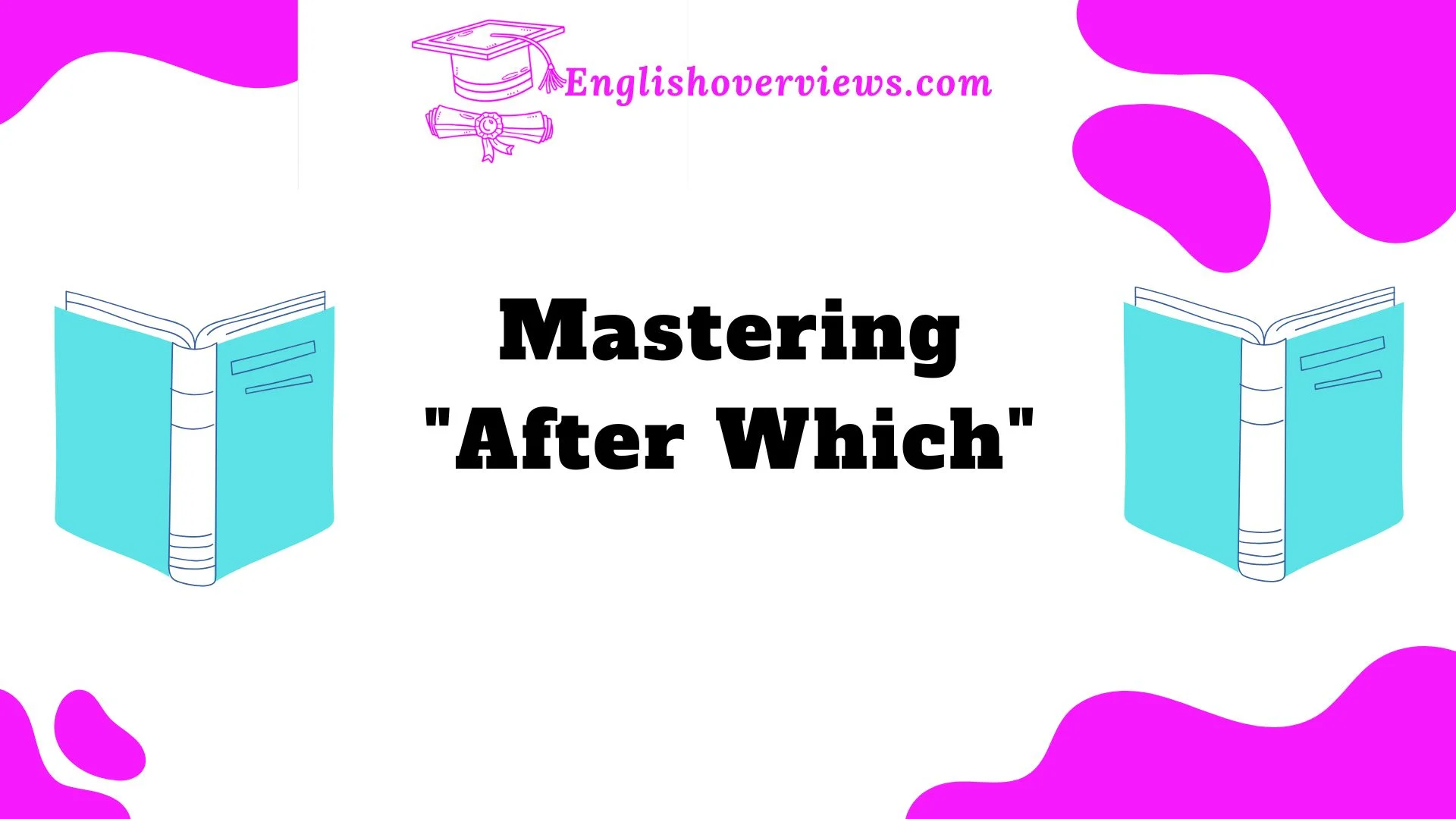When it comes to writing, connecting ideas clearly and smoothly can make all the difference. One phrase that often adds sophistication and precision to your writing is “after which.” This versatile connector helps establish relationships between events, actions, and outcomes, making your text more coherent and engaging.
But what exactly does “after which” mean, and how can you use it effectively? In this guide, we’ll dive deep into the grammar, examples, and nuances of “after which.” Whether you’re writing formal essays, creative stories, or professional documents, mastering this phrase can enhance your communication. So, let’s break it down step by step, ensuring you not only understand but can confidently use “after which” in your writing.
Understanding ‘After Which’ in English Grammar
What Is ‘After Which’?
“After which” is a relative clause connector. It links a preceding event, action, or subject to what happens next. In simpler terms, it tells us what follows after something occurs.
For example:
- He completed his degree, after which he moved to New York.
Here, “after which” ties two related ideas together, showing the sequence of events.
Grammatical Role of ‘After Which’
- Part of a Relative Clause: It often starts a dependent clause that adds information to the main sentence.
- Formality: This phrase is typically used in formal or semi-formal writing.
- Tone: It conveys a sense of order and logic.
| Key Features | Details |
| Function | Connects two events logically |
| Usage | Formal writing, narratives |
| Synonyms | Then, thereafter, subsequently |
Examples of ‘After Which’ in Action
Using examples is one of the best ways to grasp how “after which” functions in sentences.
Everyday Examples
- She submitted her resignation, after which she took a year-long sabbatical.
- The committee reviewed the proposal, after which they approved the project.
Formal Writing Examples
- The treaty was signed in 1945, after which peace was officially restored.
- He delivered the keynote address, after which a panel discussion followed.
Spoken Contexts
In spoken English, we rarely use “after which” due to its formal tone. Instead, phrases like “then” or “next” are more common. However, in presentations or interviews, it might appear:
- The product launch was a success, after which we saw a 30% increase in sales.
Pro Tip: Use “after which” to add variety to your writing and avoid repetitive transitions like “then” or “next.”
Linking Sequential Events with ‘After Which’
One of the main strengths of “after which” is its ability to link sequential events smoothly. This is particularly useful in:
- Storytelling
- Historical accounts
- Step-by-step explanations
How It Enhances Flow
Without “after which”:
- The team completed the research. The implementation phase began.
With “after which”:
- The team completed the research, after which the implementation phase began.
Notice how the second sentence feels more polished and connected?
Example: Sequential Writing in Narratives
- The train arrived late, after which passengers hurried to their destinations.
- She finished the report, after which she immediately scheduled a meeting.
From Actions to Outcomes
Beyond linking actions, “after which” also establishes cause-effect relationships.
Examples of Cause-Effect Relationships
- He invested in real estate, after which his financial portfolio grew significantly.
- The company launched a new product line, after which its market share increased.
By clearly linking actions to their results, “after which” ensures readers understand the logical progression in your narrative.
‘After Which’ vs. Similar Phrases
Common Alternatives to ‘After Which’
| Phrase | Meaning | Best Used In |
| Then | Indicates what happens next | Informal or casual writing |
| Thereafter | Immediately following an event | Formal or professional writing |
| Subsequently | At a later time | Academic or chronological accounts |
When to Choose ‘After Which’
- Use “after which” for formal settings where clarity and elegance are essential.
- Reserve “then” and “afterwards” for casual or conversational tones.
The Role of ‘After Which’ in Descriptive Writing
Naming and Origin Descriptions
Descriptive writing often uses “after which” to narrate origins or explain processes.
Example: Historical Context
- The city was founded in 1750, after which it became a major trade hub.
In Etymology or Scientific Writing
- The term was first coined in the 18th century, after which it gained widespread usage.
These examples highlight how “after which” adds sophistication to descriptive texts.
Clarifying ‘After Which’ vs. ‘Afterwards’
Many writers confuse “after which” with “afterwards.” While similar, they serve different purposes.
| Phrase | Key Difference | Example |
| After Which | Connects clauses; more formal | She spoke at the event, after which she left. |
| Afterwards | Standalone adverb; less formal | She spoke at the event and left afterwards. |
Quick Tip: If you’re joining two ideas in one sentence, “after which” is your go-to choice.
Expanding Your Vocabulary Toolbox
To avoid overusing “after which,” consider its synonyms:
- At which point
- From which
- Thereafter
- Following which
Example Sentences with Synonyms
- The festival concluded, at which point the cleanup began.
- He submitted the final draft, following which the team began their review.
Real-World Case Studies
Case Study: Business Growth
- Scenario: A company launched a marketing campaign, after which their sales doubled.
- Analysis: Using “after which” emphasizes the direct impact of the campaign on sales.
Case Study: Historical Events
- Scenario: The Civil Rights Act was passed in 1964, after which significant societal changes unfolded.
- Analysis: “After which” helps contextualize the law’s impact chronologically.
FAQs About ‘After Which’
1. Can I use “after which” in casual writing?
Yes, but it’s more common in formal or professional contexts. For casual writing, use simpler alternatives like “then.”
2. What’s the main difference between “after which” and “then”?
“After which” connects two clauses, while “then” simply indicates the next action.
3. Is “after which” outdated?
Not at all! It’s still widely used, especially in formal writing.
4. Can I start a sentence with “after which”?
No, it usually appears after the main clause.
5. What are some examples of “after which” in history?
- The Berlin Wall fell in 1989, after which Germany was reunified.
Conclusion
Mastering “after which” can significantly enhance the clarity and flow of your writing. By understanding its role, exploring examples, and practicing its use, you’ll elevate your ability to connect ideas seamlessly. Use this guide as a reference, and soon, you’ll be confidently incorporating “after which” into your work like a pro.

Alyan Ashraf is the creative mind behind English Overviews, a platform dedicated to helping learners master the English language. Passionate about education and language development, Alyan specializes in simplifying complex English concepts, making learning accessible for students of all levels.











